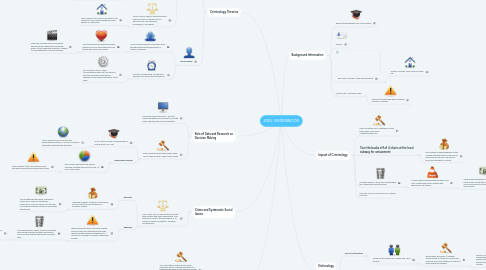
1. Criminology Theories
1.1. Sociological
1.1.1. Drift Theory: Joel has a commitment to conventional ways.
1.1.1.1. When stress is placed on this commitment (like getting lower grades than his brother) he drifts into deviant behaviour.
1.1.2. Strain Theory: Has a goal to move away and study Multimedia Productions.
1.1.2.1. Adapts to attempting to reach this goal through rebellion.
1.1.2.1.1. Joel commits minor crimes through his rebellion to attempt to influence his parents to allow him to leave due to his negative influence on the community.
1.1.3. Social Control Theory: Everyone would commit crime if it weren't for our attachments, commitments, involvement, and beliefs.
1.1.3.1. Joel commits only minor crimes due to his influence of his family attachments and beliefs of Christianity.
1.2. Psychological
1.2.1. Social Learning Theory: Individuals learn through observing the behaviour of others "modelling".
1.2.1.1. Joel has previously represented good behaviour due to the modelling of his friends and family around him.
1.2.1.1.1. With age, Joel has learned and heard about deviant behaviours through his peers, social media and television, leading to his engagement of social deviancy.
1.2.2. Classical Conditioning: conditioned stimulus and unconditioned stimulus.
1.2.2.1. Joel commits minor crimes (unconditioned stimulus), his parents become upset and increase the likelihood of him being allowed to move away.
2. Role of Data and Research on Decision Making
2.1. Media will report the crime - will only depict the details of the offence, not the reason behind why it was committed.
2.2. Data collected shows that people aged 18-34 make up 59% of adult court cases
2.2.1. Most of this number is represented by young adults, like Joel.
2.2.1.1. Joel's deviance may be due to the geographical location of a rural community associated with teenage boredom.
2.2.2. Maturational Reform
2.2.2.1. This number decreases one young offender see they have more to lose, so crime rates lower.
2.2.2.1.1. Early predictor that Joel's deviance will decrease and eventually permanently stop.
3. Crime and Systematic Social Issues
3.1. Joel comes from a community and family with equality and equal opportunity. This leaves his crime to be describes by 2 of Merton's modes of adaption: Ritualism and Rebellion.
3.1.1. Ritualism
3.1.1.1. Individual accepts a lifestyle of hard work, but will reject the cultural goal of a monetary reward.
3.1.1.1.1. Joel accepts the hard work of going to school for a career in multimedia productions, but isn't doing it for the lack of money his parents believe to associated with the job.
3.1.2. Rebellion
3.1.2.1. When individuals reject culturally defined goals and end up substituting new goals, resulting in the possible engagement in violence or vandalism to achieve their ideal society.
3.1.2.1.1. Joel defaced the 4 chairs at his local subway because he rejected the goals his parents set up for him toward taking over the family farm.
4. Evolution of Crime
4.1. Joel committed a public order crime: “behaviour that is outlawed because it is threatens the general well-being of society and challenges its accepted moral principles”
4.2. Punishment
4.2.1. Involvement in pro-social activities to regain a positive environment, perspective and influences.
4.2.2. Access to human services regarding parent-child counselling to further repair the deep-rooted family problems that may have motivated Joel to commit mischief.
5. Background Information
5.1. Below average grades-lack of motivation
5.2. Age:20
5.3. Born into a 5th gen. cattle farming family
5.3.1. Home is located 10km North of Killam, AB.
5.4. Born into a Christian family
5.4.1. Has strict parents who don't condone alcohol or drug use
6. Impact of Criminology
6.1. Has committed minor vandalism crimes that he has never been caught/punished for.
6.2. Tore the backs off of 4 chairs at the local subway for amusement
6.2.1. This creates an added expense to the Subway that they may not be able to afford due to the lack of business and small population in Killam.
6.3. Provides shame in his family and tarnishes the Underwood name/business
6.3.1. Locally owned business who get their beef from Underwood Farms disassociate themselves from them.
6.3.1.1. Those small buisnesses close down, or pay extra money to get their beef from outside sources resulting in closure, or increase menu prices.
6.4. Falls into SOCIAL DEVIATIONS in Hagans Pyramid.
7. Victimology
7.1. Direct Victimization
7.1.1. Faced my the owners of Subway and Joel's parents.
7.1.1.1. Both parties face harm; (Subway= economically) & (Parents=socially and business wise), but neither one wants to push severe punishment.
7.1.1.1.1. Instead, victims can participate in healing lodges where they tell Joel how his actions affected them, and come up with ways to prevent future occurrences, and move forward.
7.2. Secondary Victimization
7.2.1. Faced by Joel's friends who don't want to be associated with the act, and other Killam residents who enjoy the peaceful aspect of the community.
